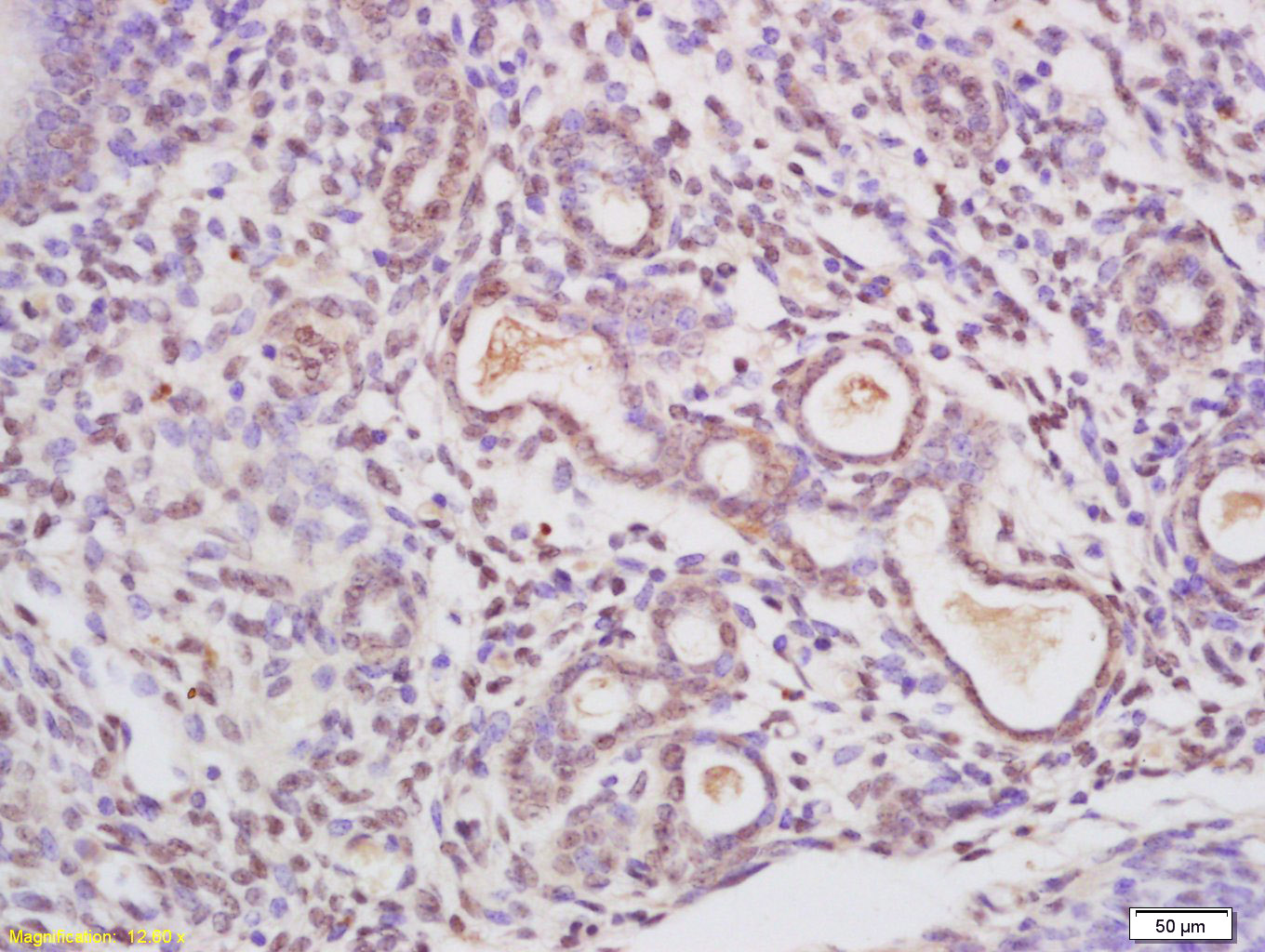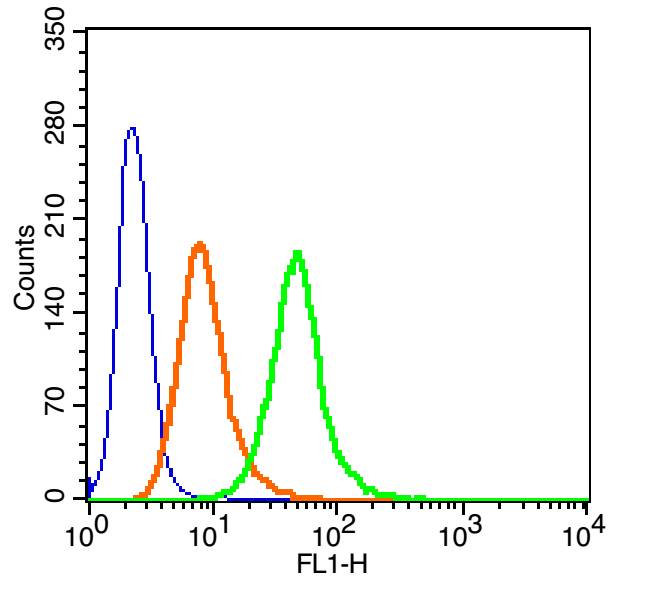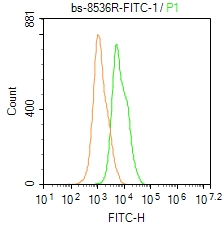
Rabbit Anti-Nucleolin/C23 antibody
C23; NCL; Nucl; NUCL_HUMAN; Nucleolin; Protein C23.
View History [Clear]
Details
Product Name Nucleolin/C23 Chinese Name 核仁蛋白C23抗体 Alias C23; NCL; Nucl; NUCL_HUMAN; Nucleolin; Protein C23. Research Area Cell biology Chromatin and nuclear signals Epigenetics Immunogen Species Rabbit Clonality Polyclonal React Species Human, Rat, (predicted: Mouse, Dog, Pig, Cow, Horse, ) Applications ELISA=1:5000-10000 IHC-P=1:100-500 IHC-F=1:100-500 Flow-Cyt=1μg/Test IF=1:50-200 (Paraffin sections need antigen repair)
not yet tested in other applications.
optimal dilutions/concentrations should be determined by the end user.Theoretical molecular weight 76kDa Cellular localization The nucleus cytoplasmic Form Liquid Concentration 1mg/ml immunogen KLH conjugated synthetic peptide derived from human Nucleolin: 601-710/710 Lsotype IgG Purification affinity purified by Protein A Buffer Solution 0.01M TBS(pH7.4) with 1% BSA, 0.03% Proclin300 and 50% Glycerol. Storage Shipped at 4℃. Store at -20 °C for one year. Avoid repeated freeze/thaw cycles. Attention This product as supplied is intended for research use only, not for use in human, therapeutic or diagnostic applications. PubMed PubMed Product Detail Nucleolin is the major nucleolar protein of growing eukaryotic cells. C23 (nucleolin, NCL) is a eukaryotic nucleolar phosphoprotein that influences synthesis and maturation of ribosomes. C23 localizes to dense fibrillar regions of the nucleolus. It contains four RNA binding domains that interact with pre-rRNA during synthesis. C23 can influence RNA processing, ribosomal gene transcription and nucleolar targeting of ribosomal components. It is known to associate with a variety of proteins, including the nucleolar protein B23. Phosphorylation by Cdc2 and casein kinase II causes translocation of C23 from the nucleolus to the cytoplasm. Mitotic phosphorylated forms of Bcl-2 are present in nuclear structures in prophase Hela cells together with C23 and Ki-67. Retinoic acid-induced apoptosis leads to C23 down-regulation and Bcl-2 mRNA instability. C23 binds the human telomerase reverse transcriptase subunit (TERT) through interactions with its RNA binding domain 4 and carboxyl-terminal RGG domain, and this interaction is critical for the nucleolar localization of human TERT.
Function:
Nucleolin is the major nucleolar protein of growing eukaryotic cells. It is found associated with intranucleolar chromatin and pre-ribosomal particles. It induces chromatin decondensation by binding to histone H1. It is thought to play a role in pre-rRNA transcription and ribosome assembly. May play a role in the process of transcriptional elongation. Binds RNA oligonucleotides with 5'-UUAGGG-3' repeats more tightly than the telomeric single-stranded DNA 5'-TTAGGG-3' repeats.
Subunit:
Identified in a mRNP granule complex, at least composed of ACTB, ACTN4, DHX9, ERG, HNRNPA1, HNRNPA2B1, HNRNPAB, HNRNPD, HNRNPL, HNRNPR, HNRNPU, HSPA1, HSPA8, IGF2BP1, ILF2, ILF3, NCBP1, NCL, PABPC1, PABPC4, PABPN1, RPLP0, RPS3, RPS3A, RPS4X, RPS8, RPS9, SYNCRIP, TROVE2, YBX1 and untranslated mRNAs. Interacts with APTX and NSUN2. Component of the SWAP complex that consists of NPM1, NCL/nucleolin, PARP1 and SWAP70. Component of a complex which is at least composed of HTATSF1/Tat-SF1, the P-TEFb complex components CDK9 and CCNT1, RNA polymerase II, SUPT5H, and NCL/nucleolin. Interacts (via RRM1 and C-terminal RRM4/Arg/Gly-rich domains) with TERT; the interaction is important for nucleolar localization of TERT. Interacts with ERBB4. Interacts with GZF1; this interaction is important for nucleolar localization of GZF1. Interacts with NVL.
Subcellular Location:
Nucleus, nucleolus. Cytoplasm. Note=Localized in cytoplasmic mRNP granules containing untranslated mRNAs.
Post-translational modifications:
Some glutamate residues are glycylated by TTLL8. This modification occurs exclusively on glutamate residues and results in a glycine chain on the gamma-carboxyl group (By similarity).
Similarity:
Contains 4 RRM (RNA recognition motif) domains.
SWISS:
P19338
Gene ID:
4691
Database links:
Entrez Gene: 4691 Human
Entrez Gene: 17975 Mouse
Omim: 164035 Human
SwissProt: P19338 Human
SwissProt: P09405 Mouse
Unigene: 79110 Human
Unigene: 154378 Mouse
Unigene: 474153 Mouse
Unigene: 144561 Rat
Product Picture
Antigen retrieval: citrate buffer ( 0.01M, pH 6.0 ), Boiling bathing for 15min; Block endogenous peroxidase by 3% Hydrogen peroxide for 30min; Blocking buffer (normal goat serum,C-0005) at 37℃ for 20 min;
Incubation: Anti-Nucleolin/C23 Polyclonal Antibody, Unconjugated(SL8536R) 1:200, overnight at 4°C, followed by conjugation to the secondary antibody(SP-0023) and DAB(C-0010) staining
Blank control(blue): Hela(fixed with 2% paraformaldehyde (10 min) and then permeabilized with ice-cold 90% methanol for 30 min on ice).
Primary Antibody: Rabbit Anti- Phospho-c-Fos (Ser32) /AF488 antibody(SL8536R-AF488), Dilution: 1μg in 100 μL 1X PBS containing 0.5% BSA;
Isotype Control Antibody: Rabbit IgG/AF488(orange) ,used under the same conditions.
Blank control: Molt4.
Primary Antibody (green line): Rabbit Anti- Nucleolin/C23/FITC Conjugated antibody (SL8536R-FITC)
Dilution: 1μg /10^6 cells;
Isotype Control Antibody (orange line): Rabbit IgG-FITC .
Protocol
The cells were fixed with 4% PFA (10min at room temperature)and then permeabilized with 0.1% PBST for 20 min at-20℃. The cells were then incubated in 5% BSA to block non-specific protein-protein interactions for 30 min at room temperature. The cells were stained with Primary Antibody for 30 min at room temperature. Acquisition of 20,000 events was performed.
Bought notes(bought amounts latest0)
No one bought this product
User Comment(Total0User Comment Num)
- No comment






 +86 571 56623320
+86 571 56623320
 +86 18668110335
+86 18668110335

